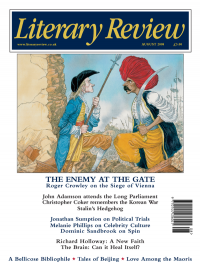Charles Saumarez-Smith
National Trust
Who Owns Antiquity? Museums and the Battle over Our Ancient Heritage
By James Cuno
Princeton University Press 228pp £14.95
I was recently asked to give a paper at a conference on the subject of ‘Collecting Practices in Lebanon’ held at the American University of Beirut. I spoke on some of the problems of adding to the collections of the National Gallery and the worrying prospect that museums and galleries in the United Kingdom would no longer be able to add to their collections in the same way that they have in the past, due to the absence of dedicated state support and the increasing cost of the greatest works of Western European art. During the questions, someone at the back of the room stood up and asked how it felt to live in a country where so much of the wealth of the Middle East had accumulated. I misunderstood the question and thought that he was asking me about my attitude towards restitution. My answer was greeted with a slight undercurrent of sarcastic laughter, since it was obvious to them that I had not given deep thought to the fundamental issue of imbalance between collections in the Middle East, the heartland of ancient cultures and civilisations, and collections in Western Europe, which have been enriched by at least two centuries of trade, wealth, archaeology and loot. The message was: you already have more than enough; you are not entitled to complain.
James Cuno, the Director of the Art Institute of Chicago and former Director of the Courtauld Institute in London, has written a book that looks at some of the issues underlying this imbalance in the world’s collections, and the attempts by national governments all over the world to maintain a

Sign Up to our newsletter
Receive free articles, highlights from the archive, news, details of prizes, and much more.@Lit_Review
Follow Literary Review on Twitter
Twitter Feed
It wasn’t until 1825 that Pepys’s diary became available for the first time. How it was eventually decrypted and published is a story of subterfuge and duplicity.
Kate Loveman tells the tale.
Kate Loveman - Publishing Pepys
Kate Loveman: Publishing Pepys
literaryreview.co.uk
Arthur Christopher Benson was a pillar of the Edwardian establishment. He was supremely well connected. As his newly published diaries reveal, he was also riotously indiscreet.
Piers Brendon compares Benson’s journals to others from the 20th century.
Piers Brendon - Land of Dopes & Tories
Piers Brendon: Land of Dopes & Tories - The Benson Diaries: Selections from the Diary of Arthur Christopher Benson by Eamon Duffy & Ronald Hyam (edd)
literaryreview.co.uk
Of the siblings Gwen and Augustus John, it is Augustus who has commanded most attention from collectors and connoisseurs.
Was he really the finer artist, asks Tanya Harrod, or is it time Gwen emerged from her brother’s shadow?
Tanya Harrod - Cut from the Same Canvas
Tanya Harrod: Cut from the Same Canvas - Artists, Siblings, Visionaries: The Lives and Loves of Gwen and Augustus John by Judith Mackrell
literaryreview.co.uk